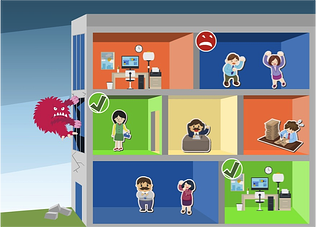Blog
6 Insights: Validating Gaming Principles Through User Testing
by Mary-Scott Hunter, vice president - client services


Laugh All You Want
By Mary-Scott Hunter | February 20, 2013 | Custom Learning | 0 Comments
 by Mary-Scott Hunter, vice president - client services
by Mary-Scott Hunter, vice president - client services
Knock, knock.
Who’s there?
No one. Corporate standards deem humor to be inappropriate in the workplace.
I am constantly amazed how often humor is shelved as an instructional strategy. You heard me — instructional strategy. In our striving to gain and maintain learners’ attention, you would think that developers of e-learning would relish an instructional strategy that has mass appeal, creates happy pheromones in learners, promotes integration of information, and remains absolutely free.
But not so.
Years of stern disapproval from legal, regulatory, and even the boss’s boss have successfully trained learning professionals to turn a blind eye to the awesome powers of hilarity. The standard disclaimers are, ‘Not everyone finds the same thing funny,’ ‘Who can say what’s truly amusing,’ and ‘Humor can veer into the inappropriate.’ All of these statements are true and yet none justify excluding this powerful instructional strategy. At worst, they point to the need for evaluating the humor included, not outright exclusion.
 Thankfully, some corporations understand that tapping the funny bone works. In November of 2012, Delta Air Lines released two new safety videos, those irritatingly familiar do’s and don’ts reviewed while the plane prepares for departure. (Both versions appear at the end of this article.) In each version, I count roughly 14 jokes.
Thankfully, some corporations understand that tapping the funny bone works. In November of 2012, Delta Air Lines released two new safety videos, those irritatingly familiar do’s and don’ts reviewed while the plane prepares for departure. (Both versions appear at the end of this article.) In each version, I count roughly 14 jokes.
Mind you, Delta isn’t the first to add humor to their safety videos. Searching on YouTube will reveal other hilarious entries from various airlines. The difference seems to be (in my opinion at least), is that while those other videos try to create something hilarious, Delta chose to use humor instructionally to emphasize their message, not mask it with laughter.
You’d think that for a serious topic (furrow your eyebrows whenever you read the words ‘serious topic’) like airplane safety, executives would steer clear of humor. I picture a gaggle of senior executives arguing around a conference table.
“We can’t,” says Jenkins. “I’m all for humor, but not when it’s a serious topic.”
Oh Jenkins...humor is appropriate in a wide range of circumstances when you know how to properly apply it. The secret is to use humor as an instructional strategy, not create a stand-up comedy act. Using Delta’s charming videos, I’ll articulate a couple useful guidelines for utilizing humor in training.
1. Use Humor to Underscore Main Points
During Delta’s video, when reminding passengers to pay attention to all posted signs, the camera turns toward the signs we’d expect: keep your seatbelts fastened, No Smoking, etc. Then, Delta-branded signs for “No Squash” and “No Juggling Chainsaws” gently come into focus.
Our humorless executive, Jenkins, might argue that a passenger would never get chainsaws past airport security. Jenkins! You’re missing the point. The learning emphasized paying attention to signage and underscored the message with gentle absurdity.
Should we fret it sends a mixed message about signage and how some might seem silly? No. The absurd signs are ridiculous enough that there is no confusion with real world signs, nor would it cause internal angst for learners as to which signs are worthy of consideration.
2. Choose not to use Humor
The Delta videos are not a series of non-stop gags. These videos aren’t trying to win 100,000 hits on YouTube. They use humor to emphasize situations, rules, and reactions. They avoid humor when it interferes with the instructional message.
For example, humor is not used at all when instructing on how to fasten seatbelts, attach an oxygen mask, or during the pilot’s final message. Why not? I believe the creators were cognizant of the learning outcomes and affective impact. Nobody wants to see their airline pilot play ‘the clown.’ We want to trust and rely in the confidence of pilots, not be wowed by their Robin Williams’ impression.
When fastening seatbelts and attaching oxygen masks, Delta has an investment in learners performing these tasks correctly, flawlessly. Their instructional designers (I believe) said, “Not here. Humor must not interfere with the steps and correct demonstration of those steps.” Good for them. Half of using humor as an instructional strategy is deciding when to hold back.
3. Use Humor to Emphasize Sameness or Differences
When asking, “Are you comfortable performing the tasks necessary in an exit row,” two of the three row mates, identical twins (dressed identically) respond in a monotone, “Yes.” The third gentleman winces slightly and says, “Not really.” He leaves and is immediately replaced by another exact replica of the first two. The twins, it turns out, are triplets.
While chuckling at the exit row trio, several instructional points got validated: everyone has to say yes or no to their responsibilities in this row, it’s okay to decline the responsibility, and all three must be equally up to the task. I’m not suggesting humor theorists write a 12-page paper analyzing this exchange (humor theorists = murderers of humor), but I can appreciate that Delta once again used humor to enhance teaching points.
Similarly, when talking about putting ‘smaller items’ under the seat in front of you, the camera shows an absurdly tiny suitcase, smaller than the size of a pop can. The absurdity contrasts the point being made and makes me think of all the times I have witnessed row mates shoving and kicking full-sized duffle bags in an attempt to make them ‘fit’ under the seat. Delta just tricked me into considering ‘what is small? What would fit? What is appropriate for that space?’
Kudos, Delta, for making me consider implementing your guidelines. That’s what you wanted from your learners all along.
4. Laugh at Ridiculous Situations
We all encounter ridiculous situations in our world — at the supermarket, other Moms at daycare, and gasp, even at work. We can laugh at their (and our) foibles without laughing at the people themselves. It’s called self-effacing humor.
While stating that the airline patrons may experience turbulence, the camera cuts to two young girls playing the popular wooden blocks game Jenga on top of their tray tables. As the plane experiences a few bumps, their eyes dart with alarm to the clattering, wiggling tower they’ve constructed as they realize their impending doom.
It’s hilarious.
Who plays Jenga on an airplane?
Nobody — which is why it’s damn funny. We’re not laughing at the girls. In fact, we share their dread that the turbulence will prematurely end their block-stacking game. We laugh at the absurdity of playing games of precision and balance in an environment almost certain to be tumultuous.
Delta found a way to laugh at a ridiculous situation while emphasizing a reality of the world of flying we all hate: turbulence.
Isn’t it possible that your work environment/training situation has ridiculous moments? Don’t you think your learners know this? Don’t you think they’d eagerly welcome the empathy and recognition when those creating their training acknowledged life’s absurdities?
Win some points with your learners and show them you get their wacky, difficult challenges.
5. Have Fun
Remember the senior executives sitting around a conference room table arguing about whether to incorporate humor? Bless their vision and faith for saying ‘yes’ eventually. But they probably weren’t the ones who came up with the many goofy jokes that work.
The people who created humor in the Delta video clearly did so with an eye toward the instructional goal. But they also were people who like to play. You can’t create humor or find appropriate humor without actually having fun. Appropriate workplace humor is a byproduct of confidence, skill, and boundaries. When your team gets all three dimensions, you can play. You can laugh.
If your folks aren’t having fun brainstorming humor as an instructional strategy, chances are it’s not that funny.
6. Test with Users
In the end, you test humor the way you’d test any instructional strategy — with end users. If they think it’s funny, it is. If they think it’s not, then it doesn’t support the learning and you must remove or modify it. Count on your learners to tell you the truth when it comes to humor. It’s one topic where each of us considers ourselves an expert.

About the Author: Mary-Scott Hunter
Comments
Would you like to leave a comment?
Related Blog Posts

By: Mary-Scott Hunter | May, 2013
Category: Custom Learning

Blog
Make 'Em Laugh: 4 Ways to Create e-Learning Courses with Humor
by Mary-Scott Hunter, vice president - client services
By: Mary-Scott Hunter | Sep, 2014
Category: Custom Learning, Strategic Consulting

Blog
Designing Thoughtful Learning Requires BRRRRAAAAAAAAIIIIIIINS
by Mary-Scott Hunter, vice president - client services
By: Mary-Scott Hunter | Aug, 2015
Category: Custom Learning, Strategic Consulting
